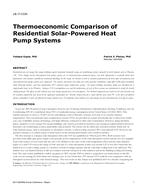Description
Residential zero net energy/low energy buildings require integrated renewable energy air conditioning systems especially in harsh climates such as Phoenix,AZ. Even though several solar-powered heat pump systems are in commercial/pre-commercial phase, very little information is available about theirperformance and economic viability for residential dwellings. In this study, the thermal as well as economic performances for three types of residential-scalesolar-powered heat pump systems were compared. The systems selected for this study were silica gel-water adsorption, single-effect LiBr-water absorption(both thermally driven), and solar photovoltaic (PV) powered vapor compression systems. An hourly building simulation model was developed for asingle-family house in the Phoenix, Arizona, USA metropolitan area and the performance of each of these systems was determined to satisfy the hourlycooling demand. The effects of solar collector area and storage capacity were also investigated. The thermal comparison was based on the solar fraction andthe economic comparison was based on the equivalent annualized cost. Results showed that for a small collector area, solar PV is the most cost-effectivewhereas adsorption is most cost-effective for larger collector area. The optimum solar collector area and storage size were determined for each type of system.
Citation: 2017 Annual Conference, Long Beach, CA, Conference Papers
Product Details
- Published:
- 2017
- Number of Pages:
- 8
- Units of Measure:
- Dual
- File Size:
- 1 file , 2.3 MB
- Product Code(s):
- D-LB-17-C030




